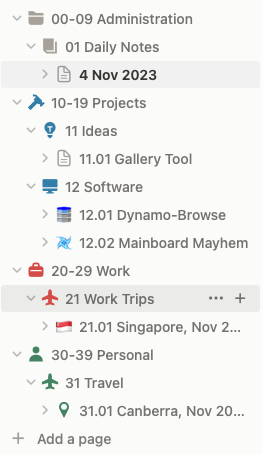-
It’s incredibly difficult to get a good photo of a Crimson Rosella. They’re quite skittish. But managed to get this shot before it flew away.

-
I’ve started using Notion for my personal notes. It’s still early days, and I haven’t moved all my old notes from Obsidian yet, but so far I’m finding it quite good for this. I still use Obsidian for work but I think the more structured features that Notion has, like databases, etc. could come in handy. It’s a little closer to my ideal note taking app, which allows for both structured and unstructured data.
Structured features begets structured notes so I’m trying to put a bit more effort into arranging my notes than I did in Obsidian. I’ve put together some sections, sort of in a Johnny.decimal lite style, where the more permanent notes will live:

Being able to set coloured icons and header images for notes is a nice touch. Sort of allows me to re-live the days of Google Inbox when they added a nice header image for travel documents:

I’m also quite impressed with the mobile app. I used it yesterday when I was out of mobile range, and not only was I still able to access my most recent notes, I was able to add new notes which eventually got synced when data was available. I didn’t test this too much and I really should as it would be good to know whether I’ve got access to most (all?) of my notes off-line.
I do miss Obsidian’s Daily Notes though. That was a nice feature for the more incidental things. But truth be told, it ended up being a dumping ground for notes that really should’ve been filed somewhere. Maybe a nice Notion feature is to add daily notes that will “disappear” after two weeks unless their moved into another section. That way you’re forced to file it or it’ll get archived/deleted.
Dare I say that it’s like “stories for notes”1? 😉
-
Maybe there should be a “stories for jokes about stories”: any joke referencing a feature that was popular five years ago should automatically get deleted. 😄 ↩︎
-
-
100% this!
It was only a year or so ago that I found out that RSS discovery was a thing (coincidentally-but-probably-not-really it was also a year or so ago when I first read Manton’s book which mentions this).
Before that, if there was a site I wanted to subscribe to, and there was no RSS link on the page itself, I wouldn’t bother. Apart from thinking that I needed the link to the RSS feed to subscribe, I also got burned so often by sites that didn’t even have RSS that I just defaulted to assuming there was no way to read their site in my feed reader.
Browsers are getting better at surfacing this though. Vivaldi now shows an RSS indicator in the address bar when it detects that the site has one. But it’s small, and I’m usually not looking at the address bar after entering the URL, so it’s easy to miss. Really, nothing beats putting a link on the site itself.
Now, if you escuse me for a second, I just need to check that I’ve got a link to an RSS feed on my site…
-
Day trip to Mornington Peninsula. Did the Bushrangers Bay to Cape Shank Lighthouse walk, the Main Ridge walk, and the King Falls Circuit walk (known to me as the “bridge walk”). Conditions were pretty good.



-
I’m more than happy to give directions to anyone who asks, but afterwards I always fear that the directions I give end up leading them astray or leave them more confused than they were. Apologies in advance to anyone I do this to (like the family that asked where the rock pools were earlier today).
-
Defaults
I see that Gabz, Robb, and Manique — along with many others — have posted their defaults after listening to Hemispheric Views 097 - Duel of the Defaults!, which was a really fun episode. I thought I’d do the same. Mail Client: Fastmail. Web-app on the desktop and app on mobile Mail Server: Fastmail Notes: Obsidian for work. It was Obsidian for personal use but I’m trying out Notion at the moment. Continue reading →
-
Also got a bit of train spotting in as well. I parked at Kyneton station in the hope of seeing a train go by. Wish I could say my timing was strategic but in truth I was just lucky.
-
Enjoyed the day in Kyneton walking along the Campaspe River trail.

-
🔗 Google is moving Shopping List and other notes into one app to worry about, Keep
This is somewhat good news, as Keep is a decent note-keeping app. But it’s also concerning because there’s now one major place to keep your data that Google might one day abandon.
It’s striking seeing this line in the first paragraph. I use Keep for my shopping list. It works well, and it’ll be a shame if Google were to shut it down. But there’s also a risk of them being too focused on the app, where they cram some useless AI feature into it. Notion does this, and I wish there was a way to turn it off.
-
Yay, six day weekend! Gonna get my day walks in. 🌲
-
While poking through some old GarageBand projects I came across this track I wrote a few of years ago. I didn’t think much of it of the time, but over the last day or so, it’s started to grow on me.
-
I’ve been asked to prepare a presentation for work, which means I have an opportunity to use iA Presenter. It’s clear that I’ll have to unlearn my Powerpointing ways.
-
One thing Slack has recently started doing is formatting CSV snippets as tables. This is a great feature. Being able to paste a CSV export directly into a channel, without having to format it as an ASCII-art table to make it readable, is really nice.
-
Will try not to make too long a comment about how I generated a report for someone, with created and updated dates for each row, and the first question they asked me is which row is the most recent one. 😒
-
Why I Like Go
This question was posed to me in the Hemispheric Views Discord the other day. It’s a bit notable that I didn’t have an answer written down for this already, seeing that I do have pretty concrete reasons for why I really like Go. So I figured it was time to write them out. I should preface this by saying that by liking Go it doesn’t mean I don’t use or like any other languages. Continue reading →
-
Got a hair cut today. Same cut as always: no. 3 round the side and trim with scissors on the top. I wonder if barbers get sick of trivial cuts like this. Wonder if it’s to cosmetology as building yet another CRUD app is to computer science.
-
Stealing an idea from Rob Knight and changing Working Set to a GitBooks powered digital garden. Still need to import the blog posts to this site before I can move the domain, but the various reference and technique posts are there now. We’ll see how long I’ll settle with this arrangement.
-
It’s interesting seeing the different names used in unit tests to identify the setup, test, and verification stages. I’ve seen “given”, “when,” and “then” used a lot in a previous role. Today I found a different convention: “arrange”, “act,” and “assert”.
-
Lunch at South Melbourne Market.

-
Happy new theme day. Figured it was time for a new look for this site so I changed the theme from Arabica to Tiny Theme by @mtt. Gotta say, looks pretty good! I’ve got some ideas for customising it slightly but love the fresh new look it gives.
-
Pro-tip: if you’re waiting outside, don’t get caught in hail.

-
Work Email Spam
Opened my work email this morning and received a greeting from the following spam messages: Webinar to “overcome the fear of public speaking” from some HR Training mob A training course on “accelerating innovation in data science an ML” (there’re a few emails about AI here) Webinars from Stripe, Slack, and Cloudflare about how other companies are using them Weekly updates about what’s happening on our Confluence wiki (this probably could be useful… maybe? Continue reading →
-
Follow-up to yesterday: I was curious to know if the click-track is only present in bounces of projects imported from GarageBand, or if it also occurs in Logic Pro projects created from scratch. After a quick test, it looks like it doesn’t matter where the project is from: the clicks are there.
-
TIL that Logic Pro will include the click-track in the bounce if it’s left on. This “feature” costed me a fair bit of rework today. I’d prefer it if the click-track is never in the bounce unless you enable it otherwise. More likely to show intent: wanting it there vs. forgetting to turn it off.
-
This conversation with @Gaby got my creative juices flowing so I though I’d put together a small video tutorial for using the GLightbox plugin by @jsonbecker. There have been a few updates with the plugin so how I use it might be slightly out of date. Either way, please enjoy.